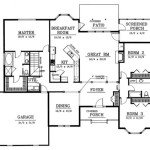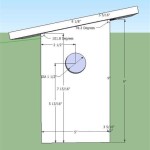Feng shui, an ancient Chinese philosophy, emphasizes the harmonious flow of qi, or energy, in a space to enhance overall well-being and prosperity. When it comes to house plans, incorporating feng shui principles can create a balanced and harmonious living environment. 1.
Main Entrance Placement:
- The main entrance should be in a commanding position, visible from the street, and easily accessible. - Avoid having the entrance directly facing a T-junction or a sharp corner, as this can create negative energy flow. 2.Proper Orientation:
- The orientation of the house should be in harmony with the five elements. - Ideally, the house should face south, southeast, or east, as these directions are associated with positive energy. 3.Balanced Layout:
- The house plan should be well-balanced, with a central axis dividing the space into two equal halves. - Avoid creating long, narrow hallways or rooms, as they can disrupt the flow of qi. 4.Kitchen Placement:
- The kitchen is considered the heart of the home, so its placement is crucial. - Position the kitchen in the southeast corner, which is associated with wealth and prosperity. - Avoid placing the kitchen directly opposite the main entrance, as this can lead to arguments and tension. 5.Living Room Placement:
- The living room should be spacious, well-lit, and inviting. - Position the living room in the northeast corner, which is associated with health and family harmony. - Arrange the furniture to promote conversation and interaction. 6.Bedroom Placement:
- The master bedroom should be located in the southwest corner, which is associated with love and relationships. - Ensure the bedroom is quiet and peaceful, with minimal clutter and distractions. - Position the bed diagonally across from the door, avoiding direct alignment. 7.Bathroom Placement:
- Bathrooms should be located in the north or northwest corner, which are associated with water and purification. - Avoid placing bathrooms in the center of the house, as this can disrupt the overall energy flow. 8.Windows and Natural Light:
- Incorporate large windows to maximize natural light and ventilation. - Place mirrors opposite windows to reflect and amplify the positive energy flow. 9.Clutter-Free Spaces:
- Maintain a clutter-free environment to allow for the free flow of qi. - Store items neatly and avoid excessive decorations, as they can create visual clutter. 10.Landscaping and Outdoor Space:
- Surround your home with lush greenery to create a harmonious connection with nature. - Incorporate water features, such as fountains or ponds, to enhance the flow of positive energy. By incorporating feng shui principles into your house plans, you can create a space that promotes balance, harmony, and well-being for all who reside within. Remember, feng shui is all about creating a harmonious flow of energy, so consider the orientation, layout, and placement of each room carefully to achieve a positive and nurturing living environment.
Simple Balance Feng Shui Home Floor Plan Ysis Nine Steps To Plans Bedroom Tips

Q A Sunday Feng Shui For New Floor Plan Aie Cho

Good Feng Shui Floor Plans For Your Home Clarendon Homes

Good Feng Shui Floor Plans For Your Home Clarendon Homes

Feng Shui Bagua Map Overlay With An L Shape Floor Plan House Showing Scientific Diagram

Feng Shui For House Layout 17 Tips Good Home Design Plan Living Room

Feng Shui House Layout 50 Architecture And Floor Plan In Cad Dwg Files Cadbull

Feng Shui Modern Home Design 3 Bed Bonus Den Guest 2 Car Mm 2247 H Hip Roof House Plan By Mark Stewart

How To Design Your Own Feng Shui House Bedroom Layout Living Room Floor Plan

What Is Feng Shui An Interior Decorating Guide Invaluable








